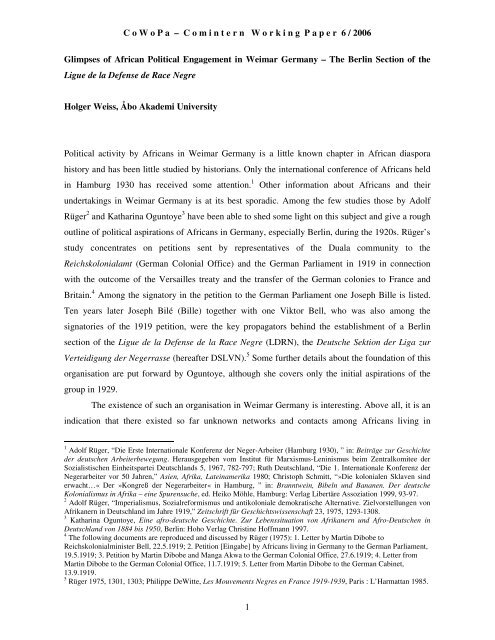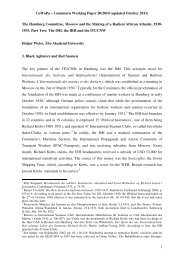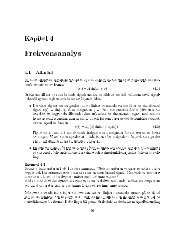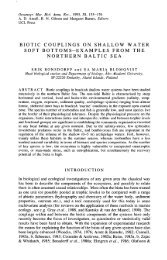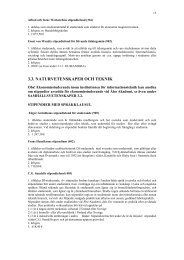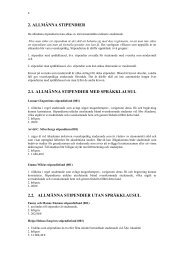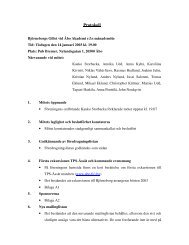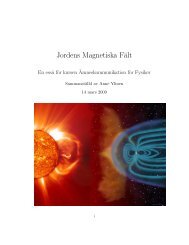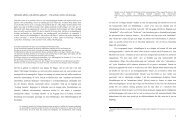C o W o P a – C omintern W orking P aper 6 / 2006 1 ... - Åbo Akademi
C o W o P a – C omintern W orking P aper 6 / 2006 1 ... - Åbo Akademi
C o W o P a – C omintern W orking P aper 6 / 2006 1 ... - Åbo Akademi
Create successful ePaper yourself
Turn your PDF publications into a flip-book with our unique Google optimized e-Paper software.
C o W o P a <strong>–</strong> C o m i n t e r n W o r k i n g P a p e r 6 / <strong>2006</strong><br />
Glimpses of African Political Engagement in Weimar Germany <strong>–</strong> The Berlin Section of the<br />
Ligue de la Defense de Race Negre<br />
Holger Weiss, <strong>Åbo</strong> <strong>Akademi</strong> University<br />
Political activity by Africans in Weimar Germany is a little known chapter in African diaspora<br />
history and has been little studied by historians. Only the international conference of Africans held<br />
in Hamburg 1930 has received some attention. 1 Other information about Africans and their<br />
undertakings in Weimar Germany is at its best sporadic. Among the few studies those by Adolf<br />
Rüger 2 and Katharina Oguntoye 3 have been able to shed some light on this subject and give a rough<br />
outline of political aspirations of Africans in Germany, especially Berlin, during the 1920s. Rüger’s<br />
study concentrates on petitions sent by representatives of the Duala community to the<br />
Reichskolonialamt (German Colonial Office) and the German Parliament in 1919 in connection<br />
with the outcome of the Versailles treaty and the transfer of the German colonies to France and<br />
Britain. 4 Among the signatory in the petition to the German Parliament one Joseph Bille is listed.<br />
Ten years later Joseph Bilé (Bille) together with one Viktor Bell, who was also among the<br />
signatories of the 1919 petition, were the key propagators behind the establishment of a Berlin<br />
section of the Ligue de la Defense de la Race Negre (LDRN), the Deutsche Sektion der Liga zur<br />
Verteidigung der Negerrasse (hereafter DSLVN). 5 Some further details about the foundation of this<br />
organisation are put forward by Oguntoye, although she covers only the initial aspirations of the<br />
group in 1929.<br />
The existence of such an organisation in Weimar Germany is interesting. Above all, it is an<br />
indication that there existed so far unknown networks and contacts among Africans living in<br />
1 Adolf Rüger, “Die Erste Internationale Konferenz der Neger-Arbeiter (Hamburg 1930), ” in: Beiträge zur Geschichte<br />
der deutschen Arbeiterbewegung. Herausgegeben vom Institut für Marxismus-Leninismus beim Zentralkomitee der<br />
Sozialistischen Einheitspartei Deutschlands 5, 1967, 782-797; Ruth Deutschland, “Die 1. Internationale Konferenz der<br />
Negerarbeiter vor 50 Jahren,” Asien, Afrika, Lateinamerika 1980; Christoph Schmitt, “»Die kolonialen Sklaven sind<br />
erwacht…« Der »Kongreß der Negerarbeiter« in Hamburg, ” in: Branntwein, Bibeln und Bananen. Der deutsche<br />
Kolonialismus in Afrika <strong>–</strong> eine Spurensuche, ed. Heiko Möhle, Hamburg: Verlag Libertäre Assoziation 1999, 93-97.<br />
2 Adolf Rüger, “Imperialismus, Sozialreformismus und antikoloniale demokratische Alternative. Zielvorstellungen von<br />
Afrikanern in Deutschland im Jahre 1919,” Zeitschrift für Geschichtswissenschaft 23, 1975, 1293-1308.<br />
3 Katharina Oguntoye, Eine afro-deutsche Geschichte. Zur Lebenssituation von Afrikanern und Afro-Deutschen in<br />
Deutschland von 1884 bis 1950, Berlin: Hoho Verlag Christine Hoffmann 1997.<br />
4 The following documents are reproduced and discussed by Rüger (1975): 1. Letter by Martin Dibobe to<br />
Reichskolonialminister Bell, 22.5.1919; 2. Petition [Eingabe] by Africans living in Germany to the German Parliament,<br />
19.5.1919; 3. Petition by Martin Dibobe and Manga Akwa to the German Colonial Office, 27.6.1919; 4. Letter from<br />
Martin Dibobe to the German Colonial Office, 11.7.1919; 5. Letter from Martin Dibobe to the German Cabinet,<br />
13.9.1919.<br />
5 Rüger 1975, 1301, 1303; Philippe DeWitte, Les Mouvements Negres en France 1919-1939, Paris : L’Harmattan 1985.<br />
1
C o W o P a <strong>–</strong> C o m i n t e r n W o r k i n g P a p e r 6 / <strong>2006</strong><br />
(Western) Europe during the post WWI period. The LDRN was in 1929 already a well known<br />
political actor in France and its founder, the Senegalese Lamine Senghor, had established contacts<br />
with various radical and leftist organizations. Although the LDRN was not a communist<br />
organisation, as the French authorities claimed, Senghor, who died already at the end of 1927, had<br />
close links with the French Communist Party (Parti Communiste Française, PCF) and communistled<br />
front organizations, especially the League Against Imperialism (LAI). Senghor was a founding<br />
member of the LAI and belonged to its Executive Committee. A key figure of the LAI was its<br />
founder, the German communist Willi Münzenberg (1889-1940). Münzenberg was the Secretary<br />
General of the LAI but, more than so, he was also the head of the Workers International Relief<br />
(WIR or Internationale Arbeiterhilfe, IAH). Moreover, he was to become a key sponsor of<br />
politically motivated Africans in Germany, as will be discussed below.<br />
However, apart from the few notes by Rüger and Oguntoye not much has been known<br />
hitherto about the further activities of the DSLVN. The main reason for this is the paucity of<br />
documentation. Rüger, in fact, does not give any references for his information about the foundation<br />
of the DSLVN by Bell and Bilé on 17 September 1929 and Oguntoye’s sketch is based only on<br />
documents found in the archives of the Reichskolonialamt. However, recent archival research by<br />
my research group in Moscow and Berlin has been able to locate some further documents on both<br />
the activities of Bilé <strong>–</strong> especially his links with Münzenberg <strong>–</strong> and the DSLVN in 1930. 6<br />
I.<br />
Little is known about political activism by Africans in Weimar Germany. One of the earliest<br />
African political organizations was perhaps the African Association for Solidarity, which existed<br />
already in 1918. Not much is known about the Association: it is unknown how long it existed, its<br />
purposes and goals, or its relationship with the state. However, according to a membership list from<br />
June 1918, the Association claimed among its membership 32 Africans all across Germany,<br />
including Berlin, Hamburg, Breslau and Bavaria. 7 At least in 1919 most of its members were still<br />
politically active as they were among the signatories of the 1919 petition. Thereafter, not much is<br />
known about political activism of Africans in Weimar Germany. Risto Marjomaa’s investigation on<br />
the activities of the League Against Colonial Oppression (LACO), the forerunner of the LAI, gives<br />
reference to two West Africans, Makube and Munumi, that were present at a meeting in the Berliner<br />
6 The original documents are reproduced as DACCO 8 and DACCO 9.<br />
7 See further Clarence Lusane, Hitler’s Black Victims: The Historical Experience of Afro-Germans, European Blacks,<br />
Africans and African Americans in the Nazi Era, Routledge: New York 2003, 84-85. Lusane obtained a copy of the<br />
membership list from Theodor Michael whose father, Th. Wonja Michael, had been a member of the association.<br />
2
C o W o P a <strong>–</strong> C o m i n t e r n W o r k i n g P a p e r 6 / <strong>2006</strong><br />
Rathauskeller on the 10 th of February, 1926: Makube was listed as representing an organization<br />
called Verein der Kameruner whereas Munumi was referred to a representative for ‘West Africa’. 8<br />
This meeting resulted in the foundation of the LACO. Also present were, among others, Otto<br />
Lehmann-Russbüldt, who was the President of the Deutsche Liga für Menschenrechte (German<br />
League for Human Rights) as well as Willi Münzenberg. As Fredrik Petersson’s research reveals,<br />
the LACO was but one of the many different front organizations that Münzenberg had established<br />
during the 1920s. 9<br />
The identity of the two Africans, Makube and Munumi, is puzzling although the few<br />
documents available give room for some speculations, especially as the spelling of African names<br />
tended to vary greatly until some kind of standardization was achieved. This was not the case<br />
during the 1920s. Thus, given the possibility of variation of the spelling, such as differences in<br />
vocalization and inserting/omitting consonants, some of the already known Africans in Weimar<br />
Germany can be discussed. In Rüger’s list of the signers of the 1919 petition there is reference to<br />
one Makembe, Hamburg, and according to Oguntoye’s investigation, 10 this was perhaps the same<br />
person as one Mukuri Makembe, who was quarrelling with the German Colonial Office in 1926,<br />
defending three Africans in a law case, and was jailed in 1927. 11 Yet, in a letter dated [?] November<br />
1931, reference is given to one Peter Makembe, living in Berlin, Kulmerstr.1. 12 Although one can<br />
argue in favour of Makembe being Makube, Oguntoye also lists one Otto Makube. However,<br />
according to the colonial files checked by her, this person was living in Bavaria, at least in 1928,<br />
and it is unlikely that he would have attended the 1926 meeting in Berlin <strong>–</strong> provided that he was<br />
already living in Bavaria at that point.<br />
On the other hand, the person referred to as Munumi is a more clear-cut case. Although<br />
neither he nor any person whose name comes close to his is not mentioned (by name) in the 1919<br />
petition, in Oguntoye’s list there is reference to one Wilhelm Munumé. This person is almost<br />
certainly the same as Munumi. The 1930 report of activities by the DSLVN (see further below)<br />
mentions the attempts by the German Colonial Office to get one of its members, Munumé, expelled<br />
8 RGASPI 542/1/4; p. 2-6 (Protocol for ”der im Berliner Rathauskeller am 10. Februar abgehaltenen Konferenz der<br />
deutschen (sic) Organisationen und der Kolonialvertreter” including participants. No year!); Risto Marjomaa, The<br />
LACO and the LAI: Willi Münzenberg and Africa, CoWoPa 4/2005, 8.<br />
9 Fredrik Petersson, ”We are no visionaries and utopian dreamers” - Fragments and Reflections Regarding the League<br />
Against Imperialism, CoWoPa 1/2005.<br />
10 Oguntoye has collected a list of Africans in Weimer Germany she has been able to identify (Personenliste:<br />
Alphabetische Namensliste der Afrikaner und Afro-Deutschen, die bis Dezember 1995 in der Untersuchung festgestellt<br />
warden konnten, Oguntoye 1997, pp. 185-193).<br />
11 Rüger; Oguntoye 1997, 190.<br />
12 BArchB RY 1/I 2/5/33, p. 122, photocopy of letter of Wilhelm Munumé.<br />
3
C o W o P a <strong>–</strong> C o m i n t e r n W o r k i n g P a p e r 6 / <strong>2006</strong><br />
by charging him for political activities and anticolonial propaganda in Germany. 13 Further, the<br />
author of the November 1931 letter was Wilhelm Munumé, living at Berlin, Kurfürstenstrasse 4. 14<br />
According to Oguntoye’s list, Munumé had already in January 1927 been jailed, presumably for his<br />
political activities. 15 The 1930 case against Munumé is interesting and will be dealt with below as it<br />
ties some further actors into the web that had been created by Münzenberg and its links to the<br />
activities by Africans in Germany.<br />
Be as it may, Makube/Makembe? and most certainly Munimi/Munumé were politically<br />
active during the mid-1920s and thus interesting for Münzenberg and others who tried to establish a<br />
critical platform against German colonial revisionism. Although no further evidence has been <strong>–</strong>so<br />
far <strong>–</strong> established for Makube’s activities, Munumé’s case gives some further insights of the political<br />
activities of the Africans in Weimar Germany at the end of the 1920s. One of the tasks of the LACO<br />
was to protest against German claims to regain their former African colonies. Therefore, it seems<br />
likely that those Africans in Germany who were engaged by the LACO were used in the agitation<br />
against German colonial revisionism. It is less clear that Makube’s and Munumé’s task was to<br />
establish contacts with West Africa, as Marjomaa assumes. 16 Munumé at least seems to have been<br />
engaged in the anticolonial agitation in Germany since 1926/27 and by 1930 had become, according<br />
to the DSLVN report, become a detestable and feared activist, if not a persona non grata, in the eyes<br />
of the German colonial lobby and especially the German Colonial Office. 17 However, it is probable<br />
that Munumé did not represent any particular organization before 1929. It is not known if he did<br />
participate in the 1927 Brussels anticolonial conference which had <strong>–</strong> officially <strong>–</strong> been organized by<br />
the LACO in February 1927 and neither are there any references about him in the correspondence<br />
of the LAI. 18<br />
II.<br />
One reason for the paucity in documentary references about African activities in Weimar Germany<br />
during the latter half of the 1920s might be due to the turbulence that marked African organizations<br />
13 RGASPI, 495/155/87, pp.404-408, Kurzer Tätigkeitsbericht der Liga zur Verteidigung der Negerrasse. Deutsche<br />
Sektion (e.V.). See further DACCO 8.<br />
14 BArchB RY 1/I 2/5/33, p. 122, photocopy of letter of Wilhelm Munumé.<br />
15 Oguntoye 1997, 191.<br />
16 Marjomaa CoWoPa 4/2005.<br />
17 RGASPI, 495/155/87, pp.404-408, Kurzer Tätigkeitsbericht der Liga zur Verteidigung der Negerrasse. Deutsche<br />
Sektion (e.V.). See further DACCO 8.<br />
18 Munumé’s name is not found in the list of participants of the 1927 Brussels conference. However, the lists of<br />
participants the research group has checked in the C<strong>omintern</strong> archive are inclusive. Only the most well-known and<br />
prominent participants seems to have been listed by name, although reference is given both in the archival material and<br />
by Itaaliander that there was quite a large participation of various colonial and ‘semi-colonial’ groups and individuals.<br />
4
C o W o P a <strong>–</strong> C o m i n t e r n W o r k i n g P a p e r 6 / <strong>2006</strong><br />
in Western Europe. It seems that there had existed no registered African organization in Germany<br />
before the establishment of the DSLVN in September 1929 as a branch of the Ligue de Défense de<br />
la Race Nègre (LDRN). 19 The LDRN had been founded by Lamine Senghor and Tiémoko Garan<br />
Kouyaté during mid-1927 as a result of a break between them and the members of another French<br />
African diaspora organization, the Comité de Defense de la Race Noire (CDRN). In fact, Senghor<br />
had been the founding member of the CDRN as well in 1926 and it was with Senghor representing<br />
the CDRN that Münzenberg and the LACO had established contacts <strong>–</strong> presumably by the end of<br />
1926. Senghor participated at the Brussels anticolonial conference in February 1927 and visited<br />
Berlin shortly afterwards 20 . Not much is known about the outcome of Senghor’s Berlin visit.<br />
However, shortly after his visit to Brussels a break followed with the CDRN in March 1927.<br />
Although the CDRN had links to the PCF, it remained outside the orbit of the party. Senghor, on the<br />
other hand, had been active in the party before he founded the Comité. When his attempt to<br />
reintegrate the CDRN to be closer linked to the party failed during spring 1927, he and Kouyaté<br />
established the LDRN which was to have good relations with the party. By August 1927 the LDRN<br />
had replaced the CDRN as a member of the LAI. However, Senghor’s premature death in<br />
December 1927 resulted in a standstill of organization and during the following year the LDRN,<br />
now under the leadership of Kouyaté, was struggling to organize itself and to create a political<br />
platform for the Africans in France. 21<br />
Further, the agitation among Africans in Germany was even more hampered by the rivalry<br />
between Münzenberg and the LAI on the one hand and the PCF on the other in 1928 and early<br />
1929. According to a report to the C<strong>omintern</strong> by British communist Robin Page Arnott, the French<br />
communists held a grunge against Münzenberg, wishing to leave the recruitment of black Africans<br />
to the LDRN which was their own protégé and had <strong>–</strong> at that time <strong>–</strong> no direct links to the<br />
Münzenberg network. 22<br />
Neither of the two platforms, the LDRN or the LAI, was capable in<br />
activating Africans in Germany, not to speak about being the motor behind an organization for<br />
Africans. Whereas the LDRN was struggling for survival in France, the LAI tried to establish its<br />
international network, leaving little time and energy for the LAI secretariat in Berlin <strong>–</strong> headed by<br />
Münzenberg and his close associate Virendranath Chattopadhyaya (1880-1937) <strong>–</strong> to organize<br />
Africans in Germany. It seems as if the main task of the LAI at this point was to establish national<br />
19 It is not known if the African Association for Solidarity was a registered organization and our research group has so<br />
far not been able to establish any direct links between the Association and the DSLVN. If the Association still existed in<br />
1927, such a link is possible as many of the identifiable activists of the DSLVN had been members in the Association.<br />
20 Margarete Buber-Neumann, Kriegsschauplätze der Weltrevolution. Ein Bericht aus der Praxis der K<strong>omintern</strong> 1919-<br />
1943, Stuttgart. Seewald Verlag 1967, 306. This visit is not mentioned by DeWitte. However, according to him Senghor<br />
received an invitation, presumably by Münzenberg, to visit Germany in August 1927.<br />
21 Marjomaa CoWoPa 4/2005. On the CDRN and the LDRN, see further DeWitte 1985, 150-154.<br />
22 Reference in Marjomaa CoWoPa 4/2005, p. 30.<br />
5
C o W o P a <strong>–</strong> C o m i n t e r n W o r k i n g P a p e r 6 / <strong>2006</strong><br />
branches, among others in Germany, France and Britain. In Germany, at least, the national branch<br />
and its local sections were more or less purely European affairs, recruiting sympathetic intellectuals,<br />
students and some workers. 23<br />
Be as it may, the LDRN<strong>–</strong>LAI relationship and their engagement with Africans in Germany<br />
were to change during 1929. The turning point was <strong>–</strong> presumably <strong>–</strong> the Second Anticolonial<br />
Conference of the LAI which was held at Frankfurt in July 1929. It is most likely that the reason for<br />
the change in approach of this matter was due to decisions made in Moscow, although so far my<br />
research group has not been able to find clear documentary evidence for this link. However, there<br />
are some documents from this period in the C<strong>omintern</strong> archive which could be interpreted as<br />
pointing towards such a change. Already in 1928 a draft on convening an international conference<br />
of ‘Negro’ workers had been put forward by Afro-American communist James W. Ford to the<br />
Profintern/RILU (Red Trade Union International). 24 According to Ford’s plan, the conference was<br />
to be held in Berlin no later than October 1929 with African/Afro-American [‘Negro’] delegates<br />
from the USA, the West Indies, Africa as well as associations such as the London Students’<br />
Organisation [presumably the West African Students Union or WASU, HW] and the Paris Negro<br />
Group [presumably the LDRN, HW]. 25 In January 1929 Ford attended the meeting of the Executive<br />
Committee of the LAI in Cologne where he criticized the LAI for inactivity, urged the LAI to<br />
promote a ‘militant’ struggle against imperialism and to take part in the upcoming conference of the<br />
International Trade Union Committee of Negro Workers. 26 Other internal reports, such as Harry<br />
Haywood’s on ‘The Work of the C<strong>omintern</strong> among the Negroes’, dated 24.10.1929, was equally<br />
critical about the performance of the PCF and the LDRN: not much had been achieved among<br />
Africans living in France due to insufficient party support. 27 Already Ford had criticized in another<br />
report, dated 14.2.1929, about the poor performance of the PCF, urging the Negro Bureau of the<br />
C<strong>omintern</strong> to set up a section in Paris as well as to monitor more closely the policies of the LAI. 28<br />
Finally, in the plan of work for the Negro Section of the Eastern Secretariat for the period between<br />
15 September 1929 <strong>–</strong> 1 January 1930, it was outlined that the Section should also establish a bureau<br />
23 See further Fredrik Petersson’s forthcoming study on the LAI.<br />
24 James W. Ford (1893-1957), one of the founders of the American Negro Labour Congress (ANLC, 1925) and since<br />
1926 member of the Workers (Communist) Party of America. In 1928 he went to Soviet Russia, where he participated<br />
in the 4 th Congress of the Profintern and was elected a member of its executive bureau. He also attended the 6 th<br />
Congress of the C<strong>omintern</strong> during the same year. He participated in the 1929 Anticolonial Congress in Frankfurt and<br />
organized the 1930 African Workers Congress in Hamburg. See further Biographical dictionary of the C<strong>omintern</strong>, ed.<br />
Branko Lazitch in collaboration with Milorad M. Drachkovitch, 2 nd ed., Stanford, Calif.: The Hoover Institution Press,<br />
1986.<br />
25 RGASPI 495/155/53, page 3: On the Convening of the First International Conference of Negro Workers.<br />
26 RGASPI 495/155/70, pp. 76.<br />
27 RGASPI 495/155/77, pp. 191-192.<br />
28 RGASPI 495/155/77, p. 222.<br />
6
C o W o P a <strong>–</strong> C o m i n t e r n W o r k i n g P a p e r 6 / <strong>2006</strong><br />
in Paris to “…assist the LDRN in issuing a regular organ for the Negroes, giving special attention to<br />
the Negro soldiers, in clarifying the problems of the Negro colonies, both in France and in the West<br />
Indies.” 29<br />
Whether or not there existed a link between Moscow and the decision to establish a branch<br />
of the LDRN in Berlin in 1929 is unclear. All key persons eventually attended the Frankfurt<br />
conference in July 1929, Kouyaté, Ford and Münzenberg, but whether they met in private and<br />
discussed future plans is not known. The 1929 conference marked a break in the development of the<br />
LAI: the organization was put closely under the surveillance of the C<strong>omintern</strong> and its watchdog in<br />
Berlin, the Western European Bureau (WEB). The International Secretariat of the LAI was<br />
supplemented with a reliable member of the Executive Committee of the C<strong>omintern</strong> (ECCI),<br />
Bohumir Smeral (1880-1941), who was to serve as one of its secretaries as well as a link between<br />
the ECCI and LAI. In September 1929 Kouyaté visited Berlin.<br />
It is not known who called and organized the meeting of the Africans in Berlin in September<br />
1929. According to DeWitte, Willi Münzenberg played a central role in calling for the meeting<br />
between Kouyaté and the Cameroonians and Togolese living in Berlin. 30 Among those who<br />
attended the meeting were Viktor Bell, Thomas Ngambi Ul Kuo, Joseph Bilé and Madeline<br />
Guber. 31 However, some further hints are given in the 1930 report by the DSLVN. It was stated in<br />
that report that comrade Konyaté [sic] founded the section in September 1929 and that its<br />
headquarters were located at Friedrichstrasse 24, sharing the same office as the League Against<br />
Imperialism. The DSLVN was regarded as a branch of the LDRN, although the section was said to<br />
have some degree of autonomy towards the central headquarters of the LDRN at Paris. On the other<br />
hand, political work of the Berlin section was led from Paris. 32<br />
It seems that at first there existed a close link between the LAI and the DSLVN. Shortly<br />
after its establishment, the LAI officials sent the representatives of the DSLVN to a solicitor to get<br />
registered by a German court and to a printer to order letterheads. LAI Secretary Chattopadhyaya<br />
promised to pay all expenses (160 Marks) for the registration and the stationery. Further,<br />
Chattopadhyaya declared that the secretary of the DSLVN would receive a monthly payment of 300<br />
Marks for his work in the office at Friedrichstrasse. In addition, ‘political courses’ and lectures for<br />
selected members of the group were organized by Smeral. 33<br />
29 RGASPI 495/155/74, pp. 18-21: Plan of work for the Negro Section of the Eastern Secretariat, 15.9.1929 <strong>–</strong> 1.1.1930.<br />
30 DeWitte 1985, 193.<br />
31 Lusane 2003, 84.<br />
32 RGASPI, 495/155/87, pp.404-408, Kurzer Tätigkeitsbericht der Liga zur Verteidigung der Negerrasse. Deutsche<br />
Sektion (e.V.). See further DACCO 8.<br />
33 RGASPI, 495/155/87, pp.404-408, Kurzer Tätigkeitsbericht der Liga zur Verteidigung der Negerrasse. Deutsche<br />
Sektion (e.V.). See further DACCO 8.<br />
7
C o W o P a <strong>–</strong> C o m i n t e r n W o r k i n g P a p e r 6 / <strong>2006</strong><br />
However, it seems as if the relationship between the DSLVN and the LAI soon deteriorated.<br />
In fact, the 1930 report of the DSLVN amounts to a fierce critique for the lack of support from the<br />
LAI and its officials towards the organization and the problems its members were facing. Neither<br />
the expenses for its establishment nor the remuneration to its secretary had been paid at the time of<br />
writing the report. The financial resources of the organization were much constrained as the central<br />
bureau in Paris had no resources to spare for the German section. Thus, the members of the DSLVN<br />
had to try with their little private financial resources to pay off debtors. Further constraint was put<br />
on the group when one of its members, Richard Dinn, died impecunious in a Berlin hospital during<br />
the Winter 1929/1930. Despite promises by the LAI secretariat to pay for his funeral, no relief had<br />
been forthcoming and the cost had to be covered by the African community of Berlin. According to<br />
the report, this lack of support and especially the non-commitment of the LAI secretariat towards<br />
the hardship the Africans were facing when they tried to meet the cost for Dinn’s funeral caused<br />
deep embitterment among them against the LAI. Also Smeral’s courses had ended with<br />
embitterment: after having organized 5 sessions within three weeks he suddenly left Germany and<br />
had not resumed his engagement although he had been in Berlin for six months after his return from<br />
abroad. 34<br />
Further constraint in the relationship between the DSLVN and the LAI was caused by the<br />
lack of support by the LAI in defending Munumé against the charges made against him by the<br />
German Colonial Office and the attempts by the German authorities to expel him from the country.<br />
Munumé was a member of the DSLVN and, as noted above, actively engaged in anticolonial<br />
propaganda. In 1927 he had been jailed due to his political activities. 35 The DSLVN tried its utmost<br />
to prevent the deportation of him and took his case also to the LAI. Chattopadhyaya again promised<br />
to do his best to defend Munumé’s case, to make it a political issue and to engage influential<br />
politicians and lawyers. Chattopadhyaya’s <strong>–</strong> and behind him most certainly Münzenberg’s <strong>–</strong> aim<br />
was to use Munumé’s case to raise the still unresolved question of the nationality of individuals<br />
from former German colonies who had been living in Germany since before the war and due to the<br />
Versailles treaty had lost whatsoever nationality they had possessed. However, nothing came out of<br />
this plan. In the end, it was only the Liga für Menschenrechte which was forthcoming. 36 In<br />
retrospect, one could argue that Chattopadhyaya’s engagement was more than lip service. The Liga<br />
für Menschenrechte was one of those organizations that had close connections with Münzenberg’s<br />
34 RGASPI, 495/155/87, pp.404-408, Kurzer Tätigkeitsbericht der Liga zur Verteidigung der Negerrasse. Deutsche<br />
Sektion (e.V.). See further DACCO 8.<br />
35 Oguntoye 1997, 191.<br />
36 RGASPI, 495/155/87, pp.404-408, Kurzer Tätigkeitsbericht der Liga zur Verteidigung der Negerrasse. Deutsche<br />
Sektion (e.V.). See further DACCO 8.<br />
8
C o W o P a <strong>–</strong> C o m i n t e r n W o r k i n g P a p e r 6 / <strong>2006</strong><br />
network, its office was also located at Friedrichstrasse 24. In addition, Munumé had been in contact<br />
with Lehmann-Russbüldt, the leader of the Liga, at least while both were engaged in the LACO.<br />
Eventually, Munumé was not expelled and about one year later he took part in an attempt to<br />
denunciate Joseph Bilé.<br />
A final blow in the relationship between LAI and the DSLVN came in 1930 in connection<br />
with the Hamburg conference of the Negro workers. According to the report, the Berlin section was<br />
urged to send a participant to the conference and was told that there would be another representative<br />
from the Paris bureau of the LNDR who had also been invited. The secretary of the DSLVN, Joseph<br />
Bilé, went to Hamburg, only to find out that due to the short notice of the conference, nobody from<br />
Paris had been able to come to Hamburg. Again, blame was put on the LAI and its secretariat for<br />
mismanagement and a laissez-faire attitude. 37<br />
By the time of writing the 1930 report, i.e., sometimes during late autumn 1930, the<br />
relationship between the DSLVN and the LAI were at its nadir. The former had received only little<br />
support and even less material backing from the LAI and its board highly questioned the<br />
advisability of being connected to the LAI instead of some other organization. In fact, since its<br />
establishment the DSLVN had participated in local activities by the German Communist Party<br />
(KPD) and the International Red Aid (IRA, also known through its Russian abbreviation MOPR 38 ).<br />
By the end of 1930, the leaders of the DSLVN were more than keen to break with the LAI and<br />
instead establish a direct relationship with the KPD and the IRA. This was also the main argument<br />
of the 1930 report, which ended with a four point list of suggestions <strong>–</strong> most likely to the KPD<br />
central secretariat as the (presumably) original <strong>–</strong> handwritten <strong>–</strong> version of the report was sent to the<br />
Berlin headquarters of the KPD although no recipient is indicated (for a critical analysis, see further<br />
DACCO 9):<br />
1) if agreement is given by the central bureau of the LNDR, the Berlin section will establish a<br />
direct connection to the KPD and that a ‘Negro comrade from Africa’ is to be included in<br />
the Colonial Section of its secretariat whose task would be to serve as a link between the<br />
DSLVN and the party.<br />
2) to establish a direct contact with the IRA.<br />
3) to organize courses for DSLVN members by the KPD.<br />
4) to send young Africans to Moscow for schooling and to send them back to Africa as cadres.<br />
37 RGASPI, 495/155/87, pp.404-408, Kurzer Tätigkeitsbericht der Liga zur Verteidigung der Negerrasse. Deutsche<br />
Sektion (e.V.). See further DACCO 8.<br />
38 The organization was known in Germany as Internationale Rote Hilfe or IRH.<br />
9
C o W o P a <strong>–</strong> C o m i n t e r n W o r k i n g P a p e r 6 / <strong>2006</strong><br />
So far the document. It is not known (yet) what happened to the report and its suggestions.<br />
However, the different communist organizations referred to in the report may give some further<br />
clues about what was going on behind the curtains in Berlin. It is evident from a variety of archival<br />
sources that the relationship between the two key international communist solidarity organizations,<br />
the IRA and the Workers International Relief (WIR) 39 were strained. This was especially the case<br />
with the key persons in those organizations, such as Wilhelm Pieck and R. Gyptner, who were<br />
closely tied to the IRA in Germany, and Willi Münzenberg, the General Secretary of the WIR. For<br />
example, an attempt to liquidate the WIR in the USA and to merge its activities with the IRA had<br />
failed in 1925 after Münzenberg’s violent protests to the ECCI, 40 whereas later on the WIR and IRA<br />
were competing with each other in their engagement in international campaigns, such as the Sacco<br />
& Vanzetti campaign during 1926-27 as well as the Scottsboro and Meerut campaigns during the<br />
early 1930s.<br />
III.<br />
According to the 1930 report, the DSLVN had 30 members of which five were women. All the<br />
members were claimed to be proletariats. They were w<strong>orking</strong> as drivers, artists, craftsmen, porters,<br />
cooks and so on. 41 Although the group was registered by the German authorities, I have so far not<br />
been able to trace any official documents concerning its organization or membership. 42 Based on<br />
Oguntoye’s and DeWitte’s material as well as other documentary evidence, it seems that Viktor<br />
Bell was the chair person of the organisation whereas Joseph Bilé was the secretary. According to<br />
information in the files of the German Colonial Office, which have been checked by Oguntoye but<br />
so far not by my research group, the German authorities had been informed by one Manga Akwa<br />
that Viktor Bell was in charge of a recently formed organization called ‘Deutsche Sektion der Liga<br />
zur Verteidigung der Negerrasse’. Manga Akwa told the authorities that he had distanced himself<br />
from the organization as he believed that it was a communist one. 43<br />
39 The WIR or the Internationale Arbeiterhilfe (IAH, founded in 1921) was the key organization of Münzenberg’s<br />
network.<br />
40 BArchB R 3003/ORA RG/Sammlung ”Rote Hilfe”/7.<br />
41 RGASPI, 495/155/87, pp.404-408, Kurzer Tätigkeitsbericht der Liga zur Verteidigung der Negerrasse. Deutsche<br />
Sektion (e.V.). See further DACCO 8.<br />
42 Presumably, the group had to deliver to the German authorities some kind of statutes and membership register, but<br />
there is no reference to this organization in the Bundesarchiv in Berlin. However, as the group was registered in Berlin,<br />
its application was perhaps filed by the local police, hence the documents might not be deposited at the Bundesarchiv<br />
but in some of the other archives in Berlin <strong>–</strong> if they survived the Nazi era and WWII.<br />
43 DeWitte 1985, 193; Oguntoye 1997, 98 ; BArchB RY 1 I 2/5/33, Letter from Wilhelm Mumuné to unknown receiver,<br />
dated 22.11.1931, p.122, see further DACCO 9.<br />
10
C o W o P a <strong>–</strong> C o m i n t e r n W o r k i n g P a p e r 6 / <strong>2006</strong><br />
Interestingly, many of the above referred Africans can be identified and connected with each<br />
other during the 1920s. At least Manga Akwa, Joseph Bilé and Wilhelm Munumé had received<br />
financial support from the German authorities during the 1920s, 44 Manga Akwa, Joseph Bilé and<br />
Victor Bell had signed the 1919 petition, Bell and Bilé (as well as Mukuri Makembe, among others)<br />
were listed in the 1918 membership list of the African Association for Solidarity, 45 and all of them<br />
were engaged in a fierce dispute in 1931-1932 (see below). Whether or not Manga Akwa’s negative<br />
attitude towards the DSLVN was based on him being critical towards communism or fearing to be<br />
attached with a communist organization which could result him losing the financial assistance he<br />
was receiving from the authorities is not known. Whatever the case, he seemed to have joined the<br />
DSLVN after some time as he is included among the signatures in a joint letter, dated 22.11.1931,<br />
from the group to the Berlin Section of the KPD. Other Africans, most probably members of the<br />
DSLVN, mentioned in the letter were Thomas Koo, Peter Makembe, Victor Bell, Louis Brody,<br />
Wilhelm Munumé, Gregor Kotto and Joseph Bilé. 46<br />
The purpose of the DSLVN was to form a union for all Africans w<strong>orking</strong> in Germany. In its<br />
turn, the combined effort of the group aimed to organize the toilers in their former countries,<br />
especially in the former German colonies. It was vaguely noted in the 1930 report that the<br />
individual members of the group had correspondence with people in various West African<br />
countries, notably Togo and Cameroun. This was not surprising as most, if not all, of the members<br />
of the DSLVN had come from the former German colonies. The group was also in contact with<br />
African workers in the harbour of Hamburg, although the plan to establish a section in Hamburg<br />
had not been realized (by 1930) due to financial constraints. 47<br />
The lack of financial resources restricted the activities of the group to Berlin. The members<br />
of the group met on a monthly basis for general meetings. Public appearances of its members<br />
occurred mostly in conjunction with political rallies of the KPD and the IRA. It seems as if<br />
especially DSLVN secretary, Joseph Bilé, was an active agitator. Participating in a political rally in<br />
Siemensstadt (Berlin) he was even for a while arrested by the police on the 6 th of March 1930. A<br />
few months later he participated in the first international conference of Negro toilers in Hamburg in<br />
July 1930 where he held a speech criticizing the activities of the French and British colonial<br />
authorities in the Cameroons. Consequently, the DSLVN <strong>–</strong> in addition to the LDRN <strong>–</strong> was listed<br />
44 Oguntoye 1997, 66.<br />
45 Lusane 2003, 85, table 5: African Association for Solidarity Membership List, June 1918.<br />
46 BArchB RY 1 I 2/5/33, Letter from Wilhelm Mumuné to unknown receiver, dated 22.11.1931, p.122, see further<br />
DACCO 9. Oguntoye’s list does not include Thomas Koo and Peter Makembe.<br />
47 RGASPI, 495/155/87, pp.404-408, Kurzer Tätigkeitsbericht der Liga zur Verteidigung der Negerrasse. Deutsche<br />
Sektion (e.V.). See further DACCO 8.<br />
11
C o W o P a <strong>–</strong> C o m i n t e r n W o r k i n g P a p e r 6 / <strong>2006</strong><br />
among the members of the International Trade Union Committee of Negro Workers (ITUCNW), 48<br />
although not much is known about the links between these organizations.<br />
Despite the DSLVN’s critique of the LAI, some of the Africans still seemed to have had a<br />
good relationship with that organization. Joseph Bilé, especially, was to be regarded by<br />
Münzenberg as a reliable chap and was invited on several occasions to speak at meetings organized<br />
by Münzenberg or the LAI secretariat. 49 Among others, he was one of the key note speakers at the<br />
Youth Congress of the LAI held in Berlin at the end of May 1931. A Negro organization, the Liga<br />
zur Verteidigung der Neger, was even an official participant at the LAI Youth Congress, according<br />
to the protocol of the congress. 50 This reference is somewhat problematic: does it refer to the<br />
DSLVN or to the LDRN? Reference is given in the list of participants to both Bilé and the Liga<br />
(“Liga zur Verteidigung der Neger sowie Neger-Genosse Bile”) which could indicate that there was<br />
also a representative of the LDRN present at the congress. During this period, Bilé participated in<br />
the Scottsboro campaign were Münzenberg and the WIR played a crucial role and, as outlined by<br />
Miller, Pennybacker and Rosenhaft, sketched a lurid catalog of abuses and atrocities in Cameroon<br />
to introduce his argument that the oppression of American Negroes was a reflex of the global white<br />
backlash against rising Negro consciousness. 51<br />
Equally puzzling is the reference to one Mariam Baker who attended the First Women<br />
Conference of the WIR (Erste Internationale Frauenkonferenz der IAH) in Berlin during October<br />
1931. Baker, who was claimed to be a Cameroonian, was one of the keynote speakers at the<br />
conference and was later to be elected as a member of the presidency of the women section of the<br />
WIR. 52 It is rather unlikely that Mariam Baker had come all the way from Cameroon to attend the<br />
conference. One possibility is that she was one of the five female members of the DSLVN, another<br />
that she was a Cameroonian living either in Britain or in France.<br />
48 RGASPI, 495/155/87, pp.404-408, Kurzer Tätigkeitsbericht der Liga zur Verteidigung der Negerrasse. Deutsche<br />
Sektion (e.V.). See further DACCO 8; A Report of the Proceedings and Decisions of the First International Conference<br />
of Negro Workers, Hamburg: International Trade Union Committee of Negro Workers 1930, 23-25, 40. I will deal with<br />
1930 Hamburg conference in another <strong>–</strong> forthcoming <strong>–</strong> w<strong>orking</strong> p<strong>aper</strong>.<br />
49 Similar argument by James A. Miller, Susan D. Penybacker, and Eve Rosenhaft, “Mother Ada Wright and the<br />
International Campaign to Free the Scottsboro Boys, 1931-1934,” American Historical Review 106:2, 2001, footnote<br />
108. In their phrasing, Bilé was Münzenberg’s protégé.<br />
50 RGASPI 542/1/51, page 81-82, Protocol of the ‘Berliner Antiimperialistische Jugendkonferenz 30-31 Mai 1931’.<br />
51 Miller, Pennybacker and Rosenhaft 2001. My research group was able to locate one obscure report in German, titled<br />
Kamerun, in the C<strong>omintern</strong> Archive in Moscow (RGSAPI 532/4/69, Kamerun [Carbon copy of a report in German on<br />
the political situation in Cameroon, no author, no date], filed as 69/No 43/Neger/5Ex 2.VI.33). With reference to Bilé’s<br />
activities, speculating about the authorship of the report, one possible author, or at least informant, of the report could<br />
have been Bilé. However, as the German language of the report is more or less that of a native speaker, it is possible<br />
that someone else than Bilé (or any other African?) actually wrote the report. On the other hand, the German language<br />
of the 1930 report <strong>–</strong> both of the printed as of the handwritten version <strong>–</strong> is also more or less of a native speaker.<br />
52 BArchB RY 9/I 6/7/2, Weltkongresse der IAH (1923, 1931).<br />
12
C o W o P a <strong>–</strong> C o m i n t e r n W o r k i n g P a p e r 6 / <strong>2006</strong><br />
IV.<br />
Joseph Bilé’s activities soon gained respect among German communists, such as Fritz Heckert, MP<br />
and representing the Profintern in Berlin. Apart from participating in the 1930 Hamburg conference,<br />
Bilé he was as a member of the Negro delegation of the LAI (or rather: represented Cameroon as a<br />
member of the LAI delegation) at the Fifth Congress of the Profintern/RILU in Moscow in August<br />
1930. After consultations at the congress, a plan was outlined by <strong>–</strong> presumably Münzenberg, at least<br />
<strong>–</strong> that Bilé should join the Berlin section of the KPD to receive further training and thereafter return<br />
to West Africa to make propaganda among fellow Africans. 53 Bilé seems to have joined the KPD as<br />
a functionary and toured for the next year in Germany where he attended rallies that were organized<br />
by the German section of the IRA as well as the WIR during the Scottboro campaign. 54<br />
While Bilé oscillated between his engagement in the DSLVN and his activities with the<br />
German communists, fellow Africans started to distance themselves from him. It is not clear what<br />
actually caused the rift between Bilé and the others, but on the 22 nd of November 1931 the Berlin<br />
headquarters of the KPD received a letter where Bilé was denunciated as a thief and charlatan: he<br />
had taken all the money that was in the treasury and had always been an enemy of the w<strong>orking</strong><br />
class. On the top of everything else, he was denunciated as being the son of a slave trader. The letter<br />
was signed by Wilhelm Munumé, who acted as the spokesperson of a fraction of key DSLVN<br />
members, including Thomas Koo, Peter Makembe, Victor Bell, Louis Brody, and Thomas Manga<br />
Akwa [spelled Aqua in the letter, HW]. 55 The comrades at the KPD headquarters were at first<br />
puzzled, then started to investigate the matter. Letters were sent to the secretariats of the IRA and<br />
the LAI, inquiring about the credibility of the allegations against Bilé, underlining that Bilé had<br />
until now been a very trustworthy comrade and functionary in contrast to Munumé, who does not<br />
seem to have gained a similar respect by the German communists. 56 In fact, Munumé had also<br />
worked with the KPD for a while, but had been suspended after a short period due to ‘unproletarian’<br />
behaviour and it was thereafter decided by the secretariat of the KPD never to engage Munumé<br />
again in any workers organizations. 57<br />
53 BArchB RY 1/I 2/5/33, page 121, letter from Münzenberg to Secretariat of the ZK/KPD in Berlin, 28.10.1930. For<br />
full text, see DACCO 9.<br />
54 BArchB RY 1/I 2/5/33, page 124, letter from the IRA German Section to the Central Committee of the KPD,<br />
25.11.1931. For full text, see DACCO 9.<br />
55 BArchB RY 1/I 2/5/33, page 122, Information and warning against [Joseph] Bilé from W. Munumé to KPD,<br />
22.11.1931. For full text, see DACCO 9.<br />
56 BArchB RY 1/I 2/5/33, page 125, Letter from ZK Secretariat KPD in Berlin to Reichsfraktionsleitung der Roten<br />
Hilfe, 27.11.1931, and page 126, Letter from ZK Sekr. KPD in Berlin to Reichsfraktionsleitung der Liga gegen den<br />
Imperialismus, 27.11.1931. For full text, see DACCO 9.<br />
57 BArchB RY 1/I 2/5/33, page 124, Letter from Reichsfraktionsleitung der Kommunisten in der R.H.D in Berlin to ZK<br />
Secretariat of KPD, 25.11.1931. For full text, see DACCO 9.<br />
13
C o W o P a <strong>–</strong> C o m i n t e r n W o r k i n g P a p e r 6 / <strong>2006</strong><br />
The immediate consequences of Munumé’s allegations are not known. However, based on<br />
the negative picture about Munumé and the praise of Bilé, it comes as no surprise that about one<br />
month later, Bilé was to figure in German communist strategies again. It is therefore likely that<br />
Munumé’s accusations either backfired or were ignored by the communist organizations in Berlin.<br />
Bilé was found to be trustworthy comrade, and the plan to send him back to Cameroon was taken<br />
up again in December 1931. In a letter from an unspecified secretary <strong>–</strong> most probably one of the<br />
LAI secretaries as it seems to have been originally Münzenberg’s and the LAI’s idea to send Bilé<br />
on a propaganda tour to West Africa <strong>–</strong> to an unknown receiver, perhaps one with the initials D.V.<br />
who responded to the request of the secretary, the plan was brought forward for consideration. 58 It is<br />
likely that those involved in the plan were the LAI and the KPD, although none of those involved<br />
can be identified. Be as it may, the plan went as follows: Bilé, who had worked among various KPD<br />
cells and sections as an Agitprop leader, was to travel to Cameroun, select competent ‘Negro<br />
comrades’ and return with them to Moscow where all of them would study at the Communist<br />
University for Eastern Workers (KUTV) or at the Lenin school. However, it appears that <strong>–</strong><br />
presumably <strong>–</strong> the LAI secretariat had not enough funds to pay for Bilé’s propaganda trip, and<br />
therefore turned to other parties, the KPD, the IRA or perhaps the IRG, and asked them whether or<br />
not they had the needed funds at their disposal. 59 Despite earlier promises, no funding had been<br />
made available and in spring 1932 Bilé declared that he would ask his family to raise the money<br />
needed to pay for his ticket. The German comrades, however, seemed to have felt embarrassed by<br />
the turn of events and sent further inquiries about both the decision to send Bilé back to Africa and<br />
the funding of his trip. 60<br />
In the end, Bilé never departed on his mission to Africa. At some point the decision was<br />
made to skip the whole plan. Some of the decision-making higher authorities or bodies <strong>–</strong> perhaps in<br />
Berlin or even in Moscow, although the archival sources at my disposal give no clue whatsoever <strong>–</strong><br />
the usefulness of sending Bilé to Africa was put into question. Travel expenses were said to be<br />
much too high. Even worse, the capability of Bilé for a successful selection of Negro students for<br />
Moscow was felt to be questionable. Maybe the negative assumptions about Bilé’s suitability had<br />
been caused by a flush of Munumé’s insinuations. Or perhaps those who made the decision did not<br />
want to take the responsibility for sending someone to Africa who would turn out to be incapable of<br />
fulfilling his task. 61<br />
58 BArchB RY 1/I 2/5/33, pp. 127-131. For full texts see DACCO 9.<br />
59 BArchB RY 1/I 2/5/33, pp. 127 + 130, letters dated 10.12.1931 and 1.6.1932 [wrong date!!!]. In fact, it was hinted in<br />
the earlier letter that according to the original plan, funds to pay for Bilé’s trip to Africa were to be forthcoming.<br />
60 BArchB RY 1/I 2/5/33, pp. 129 + 130, letters dated 1.6.1932 [wrong date!!!] and 4.4.1932.<br />
61 BArchB RY 1/I 2/5/33, pp. 131, letter dated 30.4.1932.<br />
14
C o W o P a <strong>–</strong> C o m i n t e r n W o r k i n g P a p e r 6 / <strong>2006</strong><br />
Bilé’s reactions are not known. There are no further traces about him or the Deutsche<br />
Sektion der Liga der Verteidigung der Negerrasse. Neither are there any further notes about<br />
Munumé or other members of the organization, at least not in the files that have so far been checked<br />
by my research group in Moscow and Berlin. However, other files and other archives could perhaps<br />
give some further clues. This is at least the case with Bilé who, according to Lusane, was able to<br />
escape to France after 1933. According to Lusane, Bilé continued his political activities for some<br />
years in France, publishing articles in American journals and trying to be in touch with the Africans<br />
remaining in Nazi Germany. 62 What happened to the DSLVN after Hitler’s take over is not known<br />
but not difficult to guess: as all other radical, left and/or anti-racial organization it was certainly<br />
banned and disappeared from public space, perhaps managing for some time to preserve a kind of<br />
underground network. However, public political activism was impossible for Africans in Nazi<br />
Germany.<br />
In sum, although African political activity in Weimar Germany was limited, it did exist.<br />
However, as the case of the Deutsche Sektion der Liga der Verteidigung der Negerrasse has shown,<br />
the relationship between radical Africans in Germany, various communist organizations, such as the<br />
LAI, the WIR or the IRA, or the KPD and even the C<strong>omintern</strong> was a complex one. The impetus for<br />
establishing the DSLVN clearly came from abroad and at least in the beginning the group was<br />
closely linked to its mother organization in Paris. However, it seems as if the Berlin branch of the<br />
LDRN never was planned to play an international role. Kouyaté and the LDRN were represented in<br />
the board of the ITUCNW. The latter’s office in Hamburg, first headed by James Ford and later by<br />
George Padmore, was in contact with Africans in Britain, France and the USA as well as in the<br />
colonies in Africa <strong>–</strong> but seemingly not with the DSLVN! The Hamburg office had links to the LAI<br />
secretariat in Berlin and the LAI in its turn with the DSLVN, but so far no direct link between<br />
Padmore’s office and Bilé or any other African in Berlin can be established <strong>–</strong> although they<br />
certainly met during the 1930 Hamburg conference. However, it is possible that Padmore and Bilé<br />
knew each other <strong>–</strong> through the LAI connection. Thus, perhaps the DSLVN was ‘just’ a<br />
national/regional/local section of a global network and its members were regarded by the C<strong>omintern</strong><br />
apparatus to be in the same position as any other colonial subject: not really ‘real’ communists but<br />
radical enough to be supported in the global fight against imperialism…<br />
62 Lusane 2003, 116.<br />
15


